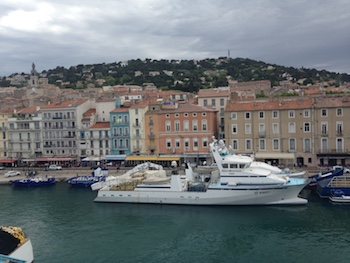The behemoths parked alongside the canal were a bit of a mystery at first when I visited Sète. Yes, it was obvious that these big boats were purse seiners meant to catch bluefin tuna: Tall piles of netting were stacked on deck while smaller powerboats were arranged on and alongside. What surprised me was that the boats didn’t go anywhere. Though crew members could be seen, standing on the decks, clamboring, leaning, sometimes painting, they didn’t seem to be doing much besides waiting while the boats stayed still.
Shiny new purse seiners dominate the pretty canal that runs through Sète, a working class port on the French Mediterranean. Melissa Wood photoAs recently as five years ago, Sète, the French town that is the largest fishing port on the Mediterranean, was also considered “ground zero in the controversial trade in bluefin.” A powerful fleet helped to catch the Mediterranean’s quota of 50,000 metric tons of bluefin per year in the 1990s. Though that overall quota dropped to the 20,000-30,000 in the mid-2000s, it was often exceeded by more than 50 percent. Fueled by insanely high prices for sushi-grade tuna in Japan, the fishery was notorious for its widespread illegal practices, disregarded quotas, total lack of oversight by authorities, large government subsidies, and a booming blackmarket trade where, as documented in a report by the International Consortium of Investigative Journalists, one in three fish were caught illegally. “We always fished more than the quota,” retired French skipper Vincent Caci, told the ICIJ. “It was normal. No one told us to stop. And France helped us build expensive new boats.”
These big, expensive boats along the canal were the survivors of that time. After many years of unaccountability, the European Union finally did begin cracking down on illegal activities, catch documents were actually filed and recorded, and traceability increased. The number of bluefin in the Mediterranean have also been increasing. In fact, last November, the international group that sets quotas (the International Commission for the Conservation of Atlantic Tunas, also known as ICCAT) approved a 20 percent increase over the next three years (a move that many environmentalists say is too much too soon).
For the fishermen of Sète, catching bluefin is still a profitable business. Asking around about the fishery, I found that the season was now shortened to just three weeks, beginning May 25 and ending June 15, or sooner, if the quota is caught before then. But even so, I was told, a crewman can make 50,000 Euros in that abbreviated season while a captain could expect upward of 500,000 Euros (roughly $57,000 and $570,000 in U.S. dollars). It’s a paycheck worth waiting for.
But what most impressed me about Sète was how fishing coexisted with the cafes and hotels demanded by the Mediterranean tourist industry. The port is on a strip of land surrounded by water with the Mediterranean on one side and the Thau, a large saltwater lagoon home to legions of oyster and mussel farms, on the other. On the inland side of Sete is the Pointe Courte, a small “short tip” that juts into the Thau. Here is a fisherman’s village tucked away behind the train station where small boats are docked to the rows of traditional fishermen’s huts that line the water while nets dry in the sun. There is even a house for “lonely cats,” as roughly translated, a tiny but clean hut just for stray cats that mostly lounged peacefully on the many little beds that were provided for them inside and out.
So while the tuna fishermen waited for that paycheck, others simply fished. Even among the idle purse seiners, small dayboat trawlers came and went. A couple evenings we watched the skipper of a small trawler go through his end-of-the-day ritual of pulling up along the quay in front of our hotel (a great place to sit and enjoy cheap but delicious wine from the region), tying up and driving his pickup truck away. His actions were not unlike the woman who ran the bicycle rental place next door, who each day closed her shop around the same time and pedaled away across the cobblestones in the late afternoon sun.







